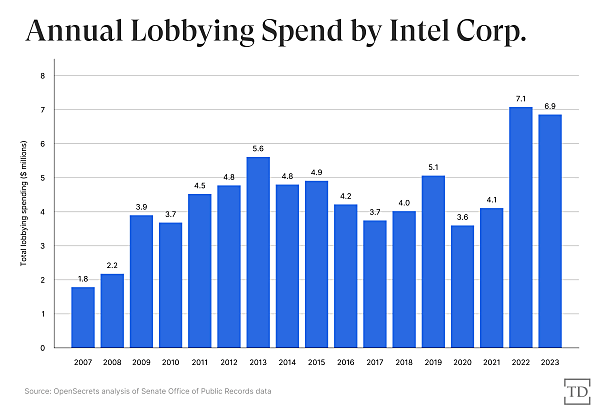That question should get resolved in the coming months as the shells get completed. Bigger CHIPS questions, however, will remain. And Intel—the top recipient of CHIPS subsidies and, per the Biden administration, our national champion—is perhaps the biggest one of all.
As you may have heard, Intel’s not doing so hot. As part of the company’s latest earnings report, CEO Pat Gelsinger announced that the company had not only lost $1.6 billion last quarter but also planned to cut 15,000 jobs (more than it promised to create under CHIPS), to pause dividend payments, and to substantially reduce capital expenditures this year and next. Since then, Intel’s already-foundering stock fell even further. As of August 10, in fact, Intel’s shares were down 68 percent since Gelsinger first announced his big “turnaround plan” in 2021. (The S&P 500 has gained 39 percent over the same period.) Intel’s stock is now trading below “book value” for the first time since at least 1981, when folks first started tracking this statistic, meaning that “investors are now valuing one of the world’s largest chip manufacturers for less than the value of its facilities and other assets on its balance sheet.”
Yikes.
For many in Washington, the CHIPS Act’s success or failure will hinge on Intel. Should the company recover from its current tailspin, the subsidies will undoubtedly be given much of the credit; should it fail, it’ll be Solyndra on steroids. But that calculus is in my view too simplistic: The real question isn’t what happens to Intel next; it’s how we got here in the first place—and how the CHIPS Act all but guaranteed that we would.
Intel’s Troubles, Past and Current
For anyone paying attention to the global semiconductor industry in recent years (and who hasn’t?!), Intel’s current troubles are hardly surprising. Indeed, one of CHIPS advocates’ dirty little secrets is that the current absence of American-made semiconductors at the industry’s bleeding edge—a common pro-CHIPS talking point—isn’t owed to a lack of U.S. industrial policy or “strategic” government planning (or whatever) but instead to one simple thing: Intel’s repeated production failures in the 2010s. As I explained in 2020, in fact, the U.S. semiconductor industry was still bragging as late as 2019 that it was (in their words) “essentially neck-and-neck [with Korea and Taiwan] in logic process technology as all three nations have raced to bring leading-edge 7/10 nm technology to market.” (Nanometers [nm] are how logic chips are usually classified: the smaller, the better.) It subsequently became clear, however, that the United States had lost its top spot in the global “nanometer race” because Intel couldn’t get its act together at 10nm. Since then, the technology has zoomed ahead but Intel seemingly hasn’t:

